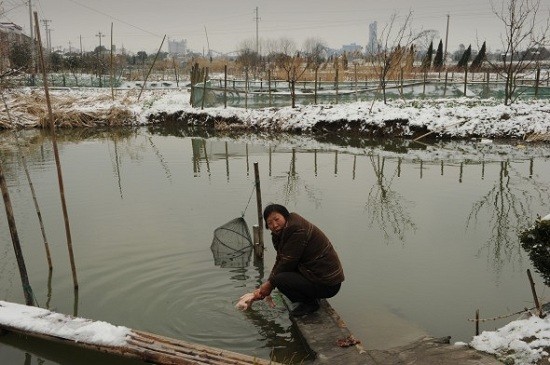
Bản đồ các làng ung thư ở Trung Quốc
Báo cáo ngày 20/2 của Bộ Bảo vệ Môi trường Trung Quốc đã gây rúng động dư luận khi công bố danh sách 247 “làng ung thư” ở 27 tỉnh, thành phố, khu vực, chủ yếu ở vùng ven biển Hoa Đông, Hoa Trung và Hoa Nam tính đến năm 2009.

Một người phụ nữ Trung Quốc đang rửa vịt để chuẩn bị cho bữa cơm tất niên
Báo cáo đi kèm với “kế hoạch 5 năm phòng chống và bảo vệ môi trường” của Bộ đã thừa nhận tình trạng ô nhiễm môi trường nghiêm trọng đang diễn ra trên khắp Trung Quốc. Vành đai ô nhiễm và các “làng ung thư” từ khu vực ven biển lấn sâu vào nội địa đã khiến số người chết vì ung thư vượt quá 1,4 triệu và tỷ lệ sông ngòi bị ô nhiễm lên tới 40%. Trong đó, tỉnh Quảng Đông đang dẫn đầu cả nước với 25 làng ô nhiễm.
Tân Hoa Xã còn cho rằng, nếu số “làng ung thư” tính đến năm 2009 là 247 thì con số thực tế tính tới thời điểm hiện tại chắc chắn đã lên trên 400.
Đây là lần đầu tiên chính quyền Trung Quốc thừa nhận sự tồn tại của thuật ngữ “làng ung thư” – một cụm từ phổ biến từ năm 1998 chỉ các ngôi làng gần khu vực kinh tế phát triển, có nhiều nhà máy sản xuất chế biến nhưng sông ngòi và đất đai lại bị ô nhiễm nghiêm trọng. Mỗi năm, Trung Quốc xảy ra 1.700 sự cố gây ô nhiễm môi trường. 3.000 trong tổng số 40.000 loại hóa chất được sản xuất và sử dụng phổ biến tại quốc gia này đều nằm trong danh sách những hóa chất nguy hiểm nhất. Trong tổng số 100 con sông chảy qua Bắc Kinh, chỉ có 2, hoặc 3 con sông đủ chất lượng để phục vụ nhu cầu nước sinh hoạt của người dân. Nhiều hóa chất độc hại đã được tìm thấy trong ao hồ, sông ngòi, vùng ven biển, trong cơ thể động vật và cơ thể người.
Trước đó, Trung Quốc cũng đã ban bố cảnh báo nguy hiểm đối với sức khỏe người dân thủ đô trước và sau Tết Quý Tị, đồng thời khuyến cáo người già, trẻ em và những người có tiền sử bệnh hô hấp hạn chế ra khỏi nhà, ngay sau khi ô nhiễm không khí tại Bắc Kinh lên tới mức báo động đỏ.
Tính riêng từ tháng 1/2013 tới nay, Trung Quốc đã phát hiện 120 vụ kinh doanh không đảm bảo vệ sinh an toàn thực phẩm, đồng thời bắt giữ hơn 350 đối tượng có liên quan. Tiêu biểu là vụ cảnh sát tỉnh Liêu Ninh triệt phá đường dây chuyên sản xuất thịt cừu rởm từ thịt vịt ôi thiu vào ngày 18/2 vừa qua. Trong vụ việc này, cảnh sát đã bắt giữ 34 người, tịch thu lượng hàng trị giá 5 triệu USD bao gồm 250 kg thịt thành phẩm, 250 kg phụ gia và hơn 10 tấn vịt thối.
China’s Mainland Home to 247 ‘Cancer Villages’
China has more than 247 “cancer villages” throughout the mainland, according to a map that is being widely circulated on the Internet.

A map of “cancer village” in China’s mainland. [File photo]
The map caught the public’s attention after the Ministry of Environmental Protection admitted earlier this month the existence of such villages and said pollution was to blame for high cancer rates among their residents.
The map was said to have been drawn up by a Chinese university student after research into data and media reports.
Although such villages are found in around 27 regions, many of them are located in central Henan and eastern Jiangsu provinces.
The number of such villages is a sharp increase compared to another widely circulated map published by social activist Deng Fei several years ago.
Deng identified just over 100 “cancer villages.”
In Yangqiao Village of Yancheng City in Jiangsu, more than 20 villagers have been reported as dying of cancer, mainly from lung and esophageal cancers, from 2001 to 2004.
The pollution in the air was so bad, it was reported, that villagers had to cover their mouths and noses with wet towels when sleeping.
In Dongjin Village in the same city, nearly 100 villagers were said to have died of cancer from 2001 to 2006 as the result of pollution caused by a chemical company. The firm offered 70 yuan (US$11) to each villager as “subsidy” after it was sued by victims, China Business Journal reported.
In a village in Henan, a total of 79 villagers died of cancer in four years after a growing number of paper manufacturing factories discharged industrial waste into river, turning it as black as ink.
The environmental ministry has published a plan to prevent and control risks brought by chemicals to the environment.
The ministry said China was still producing and using toxic chemicals which were banned in some developed countries because of their threat to human health and the environment.
“Various chemicals have been detected in some rivers, lakes and inshore waters, as well as in animals and human bodies in recent years,” the ministry said.
“Toxic chemicals have caused several environment emergencies linking to water and air pollution. Drinking water crises hit many regions while ‘cancer villages’ and other severe cases of health and social problems emerged in some other regions,” the ministry said.
According to the plan, sources polluting underground water will be under tight supervision by environmental watchdogs by 2020.
Shallow underground water in China has been severely polluted and the situation is deteriorating rapidly, with water quality data in 2011 showing that 55 percent of underground supplies in 200 cities was of bad or extremely bad quality, according to the Ministry of Land and Resources.
A review of underground water carried out by the ministry from 2000 to 2002 showed that nearly 60 percent of shallow underground water was undrinkable, the Beijing News reported yesterday.
Some reports in the Chinese media said water pollution was so severe in some regions that it caused cancer in villagers and even led to cows and sheep which drank it to become sterile.
In the latest pollution scandal, chemical companies in east China’s Weifang City were accused of using high-pressure injection wells to discharge waste sewage more than 1,000 meters underground for years, seriously polluting underground water and posing a cancer threat.
The government of the city is offering 100,000 yuan (US$16,000) to anyone who blows the whistle on companies illegally discharging waste underground. So far, no companies have been caught for polluting the environment.









































